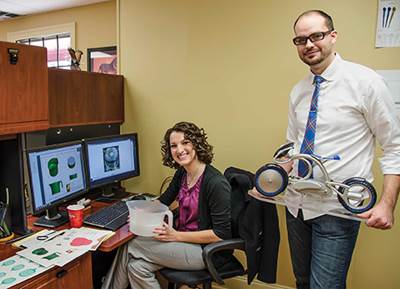‘Get the Right Information to the Right People at the Right Time’
Scott Rogers at Noble Plastics is working on production-monitoring software to empower his shop-floor personnel.
Noble Plastics’ employees are used to working with tablets to record downtime, production lots and QC checks. An in-house project would give them access to personal dashboards providing realtime analysis of whether their job’s production at the current rate is likely to meet the output goal for the shift. The cloud-based system allows operators to seek immediate technical assistance if needed. (Photo: Noble Plastics)
As Scott Rogers sees it, most manufacturers are vexed by the same persistent trio of challenges: “productivity, supply chain, skilled workers.” And in his view, two of those three are intimately linked: “The workforce has the biggest effect on manufacturing facilities. They are the only autonomous systems we have today.” Thus, as technical director of custom injection molder Noble Plastics, one of his major ongoing projects is to maximize the productive ability of his employees.
I’ve known Scott and his wife Missy (president of Noble Plastics) for 10 years or so. They founded the company in 2000 in Grand Coteau, La. The firm has grown to include a second molding plant 10 miles away in Opelousas, La., and operates a total of 19 injection machines from 35 to 940 tons with a staff of over 60 people.
Scott and Missy are both engineers, and Noble is a very technology-oriented company. Scott tends to dig deep into areas of technology that interest him, and he has spent a lot of his time lately on software development for production monitoring. His firm has experience with some of the most prominent names in plant monitoring – including Oracle and IQMS (now DelmiaWorks) – but he’s still working on his own solutions to the fundamental need, in his words, “to get the right information to the right people at the right time.” He has a technical group working on the project, including a dedicated developer, several engineers and people skilled in analytics. “We’ve funded this internally for a couple of years now, and it’s not cheap. The reason I got into this is not that I want to be a software company – I want to run a better plant.”
Scott’s approach to production monitoring is distinctive in at least a couple of ways. One is that his current focus is on the flow of information to people, not to smart machines or computers. The second is that his focus is on getting information not to supervisors or managers but to people responsible for running machines. Too often, Scott says, monitoring systems treat workers as manufacturing assets, like machines. “Anytime we start tracking what people do in a plant, it’s easy to think of tracking employee performance. We want people to get the information they need relevant to their particular job as quickly as possible. It’s no good to have information sitting out there in the cloud when too often the people who need the info are a few levels down from people who even know how to look for it.”
As a result, he says, “We are creating an engine to recognize and route information to people who need it wherever they are.” The information is cloud-based, and it is accessed in the form of a personal dashboard for each operator, using a smartphone or tablet. (Noble Plastics operators have used tablets for at least a decade to record downtime, production lots and QC checks.)
When workers log into the system, they select what work cell they will be responsible for on that shift. Their personal dashboard predicts that cell’s goal for the shift in terms of number of good parts, allowable rejects and cycle-time range for that job. Whenever they look at their dashboard, they will see it color coded with green indicating “On Track,” yellow indicating that their shift production goal is “At Risk,” and red signifying that the goal is “Not Achievable.”
The shift’s production goal is presented as a circle analogous to a clock face, with the shift’s beginning and end at the 12:00 position. In real time, a mark appears on the circle to indicate “You Are Here” in progress toward the goal. And an arc in gray surrounds the circle – Scott calls this the “Arc of Uncertainty” because it presents a calculated range of outcomes by the end of the shift. It’s based on real-time assessment of operating efficiencies and indicates the maximum and minimum anticipated result based on current efficiency and the nominal standard. If the operator is ahead of schedule, the maximum level could be greater than 100% of the expected standard. In such a case, Scott points out, an operator or technician might be tempted to extend the cycle slightly – for instance, to reduce the chance of a part sticking in a cavity. The Arc of Uncertainty would adjust to show whether that change increased the probability that shift-end results might undershoot, not overshoot, the standard.
A vital element of the system is that it allows an operator to send a message asking for assistance. “Ask anyone, ‘Have you ever had trouble finding the right person to fix this? How often have you heard, “Oh, man, I saw that alarm and I forgot about it.”’ The goal is to act right away to solve problems – stuck parts, water or oil leaks, material problems. We’re asking ourselves what we can do to make sure people don’t waste their time on unproductive things. That’s not only bad for the company but for individuals. Nobody gets fulfillment from wasting time.”
Scott and other managers have their own dashboards that show how each cell is performing. “We want to predict when a job will be finished and whether we will have met our goals.” When the software technical group meets, they come up with suggestions like, “Here’s something we really want to track.” According to Scott, the company’s molding manager wants better notification of when a job is within a few hours of finishing, in order to prepare for the next changeover. “We need the operator to verify the part counts so we don’t end up short or with overage. And are our reject counts accurate?”
This production monitoring project prompts Scott to envision another long-term goal. “What we really need is more data for industry benchmarking of OEE (overall equipment efficiency), machine utilization by clamp tonnage, cycle times for different materials, breakdown of cycle time by phases such as clamp opening and closing, downtime and scrap by age and type of machine. For example, tracking machine age vs. performance would be valuable for calculating ROI.
“With this data, I could wake up each morning and see how I’m doing. But it would take a collective effort of probably at least 50 molders. By my research, I’d say most molding machines are in shops of no more than 40 presses. Small companies can’t generate Big Data on their own. But working together and combining data anonymously would help everyone and wouldn’t hurt anyone. It’s not giving anything away.” But the end result would be valuable to all.
Related Content
Medical Manufacturer Innovates with Additive Manufacturing and Extrusion Technology Hubs
Spectrum Plastics Group offers customers two technology hubs — one for extrusion, the other for additive manufacturing — to help bring ground-breaking products to market faster.
Read MoreNovel ‘Clamtainer’ Extends Thermoformer's Reach in Packaging
Uniquely secure latching expands applications for Jamestown Plastics’ patented clamshell package design.
Read MoreSecondary Injection Unit Provides Primary Benefits for Molder
Core Technology Molding turned to Mold-Masters E-Multi auxiliary injection unit to help it win a job and dramatically change its process.
Read MoreThermoformer Maximizes Productivity with 3D Printing
Productive Plastics has created an extensive collection of 3D printed manufacturing aids that sharply reduce lead times.
Read MoreRead Next
Technology, Creativity, and Fun: The Noble Plastics Recipe
Most people find jobs within companies thatahave an established corporate mission and business culture.
Read MoreLead the Conversation, Change the Conversation
Coverage of single-use plastics can be both misleading and demoralizing. Here are 10 tips for changing the perception of the plastics industry at your company and in your community.
Read MoreSee Recyclers Close the Loop on Trade Show Production Scrap at NPE2024
A collaboration between show organizer PLASTICS, recycler CPR and size reduction experts WEIMA and Conair recovered and recycled all production scrap at NPE2024.
Read More































